
Recent Blog Posts
June 7, 2016
Random Thoughts and Happenings
Wanted to keep you updated on all that is going on at the moment. So much to share!
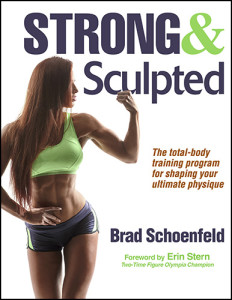
In case you haven’t heard, my newest consumer book called Strong and Sculpted, was released a few weeks ago. Happy to report it’s been the top-selling new book in Amazon.com’s “weight training” category and has gotten stellar reviews from consumers and pros alike. It’s a scientifically-based handbook for optimizing muscle development, providing step-by-step guidelines for program design. Check it out! In addition, my upcoming textbook called, Science and Development of Muscle Hypertrophy, is scheduled to be released at the end of the month. It will be the first text to provide an evidence-based perspective on muscle growth, covering all the research and its practical implications. If you’d like to be amongst the first to receive the book, it’s now available for pre-order on Amazon.com at a 20% discount.

I have a number of speaking engagements schedule for this summer. First up is Bropocalypse 2016 taking place on June 11th and 12th in Sydney, Australia. I’ll be speaking with uber-colleagues Alan Aragon, Bret Contreras, and James Krieger on what will be a terrific weekend of evidence-based learning. Next up is the NSCA National Conference in New Orleans this July, where I’ll speak on loading strategies for maximizing muscular gains. Then comes the CanFitPro World Expo in Toronto, Canada where I’ll be speaking on a number of fitness- and nutrition-related topics, as well as doing a book sign at the expo. Finally, at the end of August I’ll be in Oslo, Norway at the AFPT Fitness Convention along with some of the best and brightest minds in fitness. Last year’s event was a sell-out so if you’re planning to attend book early!
January 20, 2014
2014 Speaking Schedule
Here is my speaking schedule for 2014. I’ll update the page as new dates are added.
• January 24: Private Seminar, Bath, UK
• January 25: Private Seminar, London, UK
• March 21: Sports Nutrition and Human Performance Conference, Tampa, FL
• May 2-3: Fitness Summit, Kansas City, MO
• May 15-16: BodyPower, Birmingham, England
• May 30-June 5: Private Seminar, Reykjanesbaer, Iceland
• June 21: ISSN National Conference, Clearwater, FL
• June 26-28: 4th NSCA International Conference, Murcia, Spain
• July 11: NSCA National Conference, Las Vegas, NV
• July 26-27: Private Seminar, Limerick, Ireland
• August 7-10: CanFitPro, Toronto, Canada
• August 16: Private Seminar, Montreal, Canada
March 20, 2013
NSCA Personal Trainer Conference 2013 Recap: Part 2
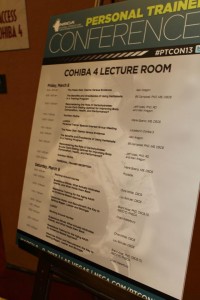
Day 2 of the 2013 NSCA Personal Trainer Conference, held on Saturday, March 9, was as eventful as Day 1 (for a full review of Friday’s events, see my previous post). For me, it was even more so. I presented twice: at 9 am and again at 2 pm. Given my speaking schedule as well as the fact that I had a number of NSCA-related meetings throughout the day, I unfortunately missed out on several sessions that I really wanted to see including presentations by Lou Schuler, Nick Winkelman, and Martin Rooney. Nevertheless I was able to attend a number of excellent lectures. Here’s the lowdown.
First session of the day was presented by Jim Kielbaso, a top-level strength coach who specializes in training athletes. Given Jim’s background, his topic was very appropos: “Should You be Training Your Personal Training Clients Like Athletes?” Jim is a very polished speaker and his lecture was peppered with personal anecdotes from working with numerous players in the NFL and NBA. As Jim noted, most people couldn’t care less about gaining extra few inches on their jump height or decreasing their sprint time by a couple of seconds. All they want is to look better and be healthier. The take-home message here was that you should never inflict your own biases when training a client. In this regard, the fitness goals of a stockbroker, truck driver, and housewife will invariably be different than that of an elite athlete. Accordingly, they will require a different training approach than if you were working with Michael Jordan.
Next up, my session on “The Science of Squatting.” Squatting biomechanics has become one of my fitness hobby-horses. In 2010, I published an article in the Journal of Strength and Conditioning Research titled, Squatting kinematics and kinetics and their application to exercise performance.” The article extensively reviewed the literature on squats, and made practical recommendations for optimal performance. Subsequently, I wrote several articles for NSCA publications on the controversy over deep squats, including a point-counterpoint position statement in a recent issue of the Strength and Conditioning Journal. My lecture at the Personal Training Conference covered a variety of topics. I began by detailing the applied anatomy and kinesiology for each joint involved in the squat, and then delved into an array of performance-related issues including bar placement, gaze, stance, knees-over-toes, and of course, squat depth. A big debt of gratitude to Bret Contreras and Alan Aragon for introducing me–the dual introduction was an NSCA first. I was humbled by their sentiments as they are two of the people I respect most in the field. Here is a clip from my presentation.
embedded by Embedded Video
Following my presentation, I went to check out the lecture by Dr. Brent Alvar–one of the world’s leading strength and conditioning researchers–who spoke about evidence-based resistance training. Brent is not only a good friend, but he is also one of my mentors. He serves as the chairperson of my PhD dissertation committee, and has furthered my advancement as a research scholar. I owe him a huge debt of gratitude. In this lecture, Brent focused on training elderly adults as a means to discuss evidence-based practice. What impresses me most about Brent is that he isn’t just a lab geek. Rather, he has held positions as a personal trainer, strength coach, facility operator, and pretty much every other job you can think of in the field. The insight into practical application was readily evident in his presentation. Brent outlined a systematic approach to program design, discussing how to begin with a review of literature and then apply the information to the individual client by using logic and experience. As Brent made clear, a well-designed regimen will always be a blend of science and art; but you can’t be an artist without knowledge of the existing evidence.
The final session I attended was given by Chad Waterbury. Chad’s presentation was titled, “Maximize Motor Unit Recruitment: the Key to Getting Bigger, Leaner and Stronger.” This was the first time I’d heard Chad speak and it’s no wonder he’s such a popular fitness pro. His delivery was smooth and he displayed a clear confidence in the material. He provided definitive opinions on the best methods for maximizing motor recruitment, and discussed how this related to optimizing strength, power, and endurance. He concluded the presentation by explaining ways to incorporate his methods into program design, delving into the specifics of sets, reps, and frequency.
Summing up, this was an incredible conference in every facet. Big thanks to the NSCA for putting on such a well-run event. Looking forward to the National Conference in July…back in Vegas 🙂
Cheers!
Brad
March 14, 2013
NSCA Personal Trainer Conference 2013 Recap: Part 1

The 2013 NSCA Personal Trainer Conference was held at the newly renovated Tropicana Hotel in Las Vegas. The conference took place over two days: Friday March 8 and Saturday March 9. I was slated to speak on Saturday. My topic: The Science of Squatting.
I arroved in Vegas around 11 pm Thursday evening after teaching a kinesiology class until 4:30 pm EST. I’m in New York so the flight is 5 hours with a 3 hour time difference. To say I was jet lagged upon arrival is akin to saying the Ronnie Coleman is somewhat muscular. Didn’t matter. I was stoked for the conference.
For those who’ve never been to an NSCA event, the quality of speakers and topics is always top notch. I’ve attended every NSCA Personal Trainer Conference for the past decade; this was without question the best line-up of presenters ever assembled.
Sessions ran from 8 am to 5 pm on the hour with a lunch break from 12-1 pm. Each session lasted 50 minutes.
The format of the Personal Trainer Conference allows for each speaker to present the same topic twice in a given day; once in the morning and once in the afternoon. Four speakers are presenting at any one time, so this affords attendees two opportunities to see a presenter of interest. Still, even if you go to as many sessions as possible, you will still miss out on some presentations. Because of these limitations, I unfortunately was unable to attend the sessions of a number of excellent presenters. These included uber-trainer Jay Dawes, speed-training guru Loren Landau, nutrion expert Marie Spano, the always innovative and creative Nick Tumminello, Alwyn Cosgrove, Phil Kaplan, Robert Linkul, JC Santana, Fraser Quelch, and a few others. What’s more, Lou Schuler, Nick Winkelman, and Martin Rooney all presented at the same time that I did, so unfortunately I missed out on these sessions as well.
So with this as background…what follows is my overview on what transpired. I’ve divided the post into two parts. Here I’ll go over Friday’s events; in Part II I’ll cover Saturday.
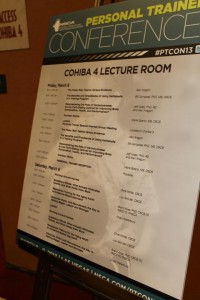
The first session I attended on Friday morning was by my good friend and colleague, Alan Aragon. I had the pleasure of introducing Alan here, and noted that he is as knowledgeable about nutrition as anyone in the field. Just as importantly, he understands practical application of nutritional principles to real-world dietary practices. This is a skill that’s lacking for many in the field. Alan’s topic was titled, “The Paleo Diet: Claims Versus Evidence.” He systematically took apart all the claims of the diet, discussing logical fallacies and flaws in the interpretation of research. The overriding point was not that there is anything inherently wrong with the diet itself, but rather that it is not the be-all-end-all way to structure a nutritional regimen. Chalk one up for science 🙂
The second session of the day was given by Dr. Len Kravitz, a professor in the exercise physiology department at the University of New Mexico. I’ve known Len for years and he is without question the most polished speaker on the fitness circuit today. His energy and enthusiasm are contagious. His content superb. His powerpoints unsurpassed. I’ve often joked that Len could recite the alphabet and make it interesting. In this lecture he discussed various strategies to enhance metabolism. One area of focus was non-exercise activity thermogenesis (NEAT). Simply stated, NEAT is every activity you do other than formal exercise, and even includes things such as fidgeting. A take home point Len made was to incorporate regular “NEAT breaks” where you get up from your chair and just take a walk around. Doesn’t sound like much, but research shows that this alone can burn a significant number of calories. He also discussed performing metabolic circuits for fat loss. These included some novel exercises, demonstrated in video clips by strongman competitor Jonathan Mike. As expected, an overall terrific presentation.
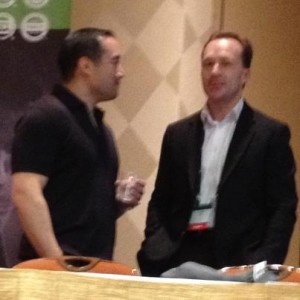
Next up came an eagerly anticipated session: the debate between Alan Aragon and low-carb research expert Jeff Volek titled, “Reconsidering the Role of Carbohydrates: Is Low Carb Dieting Optimal for Improving Body Composition, Health, and Performance?” Alan did an excellent job reviewing this session on his blog here so I won’t rehash what transpired. Instead, I’ll offer my opinion of the debate. Although both speakers did an excellent job presenting their positions, my take after seeing both the morning and afternoon sessions is that Alan had the clear advantage from an evidence-based standpoint. He was able to refute virtually all of Jeff’s points, and make a strong case that carb intake should be based on individual needs with most doing well with moderate consumption. I’ll also note that I had a chance to speak to Jeff following the presentation. He told me that his primary interest in low carb diets deals with those who are either diabetic or pre-diabetic. He conceded the diet is not ideal for gaining muscle and said he doesn’t feel it confers any advantage over non-ketogenic from a weight loss standpoint. As reflected both in the literature and through experience, optimum nutrition is highly individualized. I predict that nutrigenomics is our future, where diets will be customized based on a cheek swab of a person’s DNA. The technology is already here. It just needs to be perfected. That day is coming, perhaps soon.
The final session before lunch was given by my good friend and frequent collaborator, Bret Contreras. Bret is affectionately known as “The Glute Guy.” And for good reason. No one, bar none, knows more about the gluteals and their form and function than Bret. Heck, he’s doing his PhD on the topic! Not surprisingly, Bret’s presentation was titled, “The Science of Glute Training.” Despite knowing Bret for years, this was actually the first time I had the priverlege to see him speak. He didn’t disappoint. Bret has a unique presentation style. His sense of humor balances high-level technical content. He covered a wide array of topics on the glutes, including their five major roles and the varying torque angles associated with different glute exercises. What I found most interesting were the many tidbits of info Bret provided as to how train the muscle for optimal strength, power, and muscular development. The perfect blend of science and application.
Following lunch, I stopped in to see Joe Dowdell’s presentation, “Structuring the Training Session for Optimal Results.” Joe is one of the top trainers in the industry. His knowledge of programming is vast and backed by years of practical experience. Joe’s session was a “hands-on” presentation where he actively took attendees through his recommendations. This included various warm-up and activation activation drills, as well as specific exercises designed to enhance improvements in body composition. Very useful info.
The final session of the day was “Benefits and Drawbacks of Using Kettlebells in a Training Program” by Dr. Bill Campbell. Bill is a noted professor and researcher at the University of South Florida in Tampa. As you might expect, his presentation was a research-based analysis on the use of kettlebells. Bill did an excellent job overviewing the peer-reviewed literature investigating kettlebells as a modality. It was a balanced lecture that touched on the implications of using kettlebells to improve body composition, strength/power, metabolism, and low back pain. The evidence is still evolving on the topic, and Bill highlighted directions for future research.

Following Friday’s sessions, there was a social by the pool where all attendees and speakers got to mingle and network. Had a glass of Cabernet…or perhaps two. It was great to get a chance to meet a lot of trainers who I’ve corresponded with through social media but had never spoken to personally. I then went to dinner with a number of friends including Bret Contreras, Alan Aragon, Joe Dowdell, Dan Trink, Nick Tummniello, Lou Schuler, and Chad Waterbury. A power-gathering of fitness pros if there ever was one.
It was an action-packed day. Fortunately, there was still another full day of presentations to come as well as my own lecture. More on that in the next post.
Cheers!
Brad
July 17, 2012
Reflections from the NSCA National Conference 2012

There are two things I really enjoy about going to fitness conferences. First is the opportunity to attend presentations and learn cutting-edge info from those in the field whom I respect and admire. And second is to meet up with other fitness pros in a conversational environment and discuss topics of interest. There is no better venue to accomplish these dual objectives than an NSCA event–particularly the NSCA National Conference. Presenters are consistently the top guys in the field and the NSCA membership is as dedicated and knowledgeable about fitness as any you will find. The 2012 NSCA National Conference, held at the Rhode Island Convention Center in Providence from Wednesday July 11th to Saturday the 14th, did not disappoint!
Given my involvement with the NSCA (I had several meetings as well as two lectures to present) I unfortunately was unable to attend several presentations that I’d really looked forward to seeing. These included talks by Eric Cressey, Lou Schuler, Nick Winkelman, JC Santana, Jay Dawes, and others. That said, I did manage to find the time to catch a few select talks. Here’s a brief overview of these seminars:
1) Dr. Bill Kraemer: For those of you who do not know, Dr. Kraemer is the pre-eminent researcher in strength and conditioning. He’s probably published more peer-reviewed papers on the topic than anyone in history and serves as the editor-in-chief of the Journal of Strength and Conditioning Research. He’s been a mentor to me and I have the utmost respect for his accomplishments. Dr. Kraemer lectured on concurrent training which, simply stated, is the performance of both resistance exercise and aerobic training during a given time period. His lecture highlighted research on the topic showing an incompatibility between the two. The technical detail was well balanced with practical application. Interestingly, Dr. Kraemer pointed out that research shows that running has a significantly greater negative effect on strength and hypertrophy compared to cycling. “Exercise antagonism” was discussed, where the anabolic stimulus of resistance training is countered by the catabolic effects of aerobics. Dr. Kraemer proposed that this incompatibility can be minimized by careful periodization that allows sufficient rest and recovery. Lots of great take-home info.
2) Dr. Michael Roberts: I was not familiar with Dr. Roberts until this conference, but came away very impressed with his knowledge and professionalism. His topic delved into the effects of physical activity on disease prevention. Dr. Roberts presented research from his lab showing that when rodents were kept sedentary (their lab uses a cool device that locks the running wheel so the rats cannot run), they rapidly develop all sorts of cardiovascular and metabolic complications. Dr. Roberts showed correlative evidence that this occurs in humans, too. His take home message was to get at least 10,000 steps a day. He pointed out that modern hunter-gatherer populations accumulate twice this amount and have almost no lifestyle-related disease. A powerful presentation! Made me want to get a pedometer 🙂
3) Dr. Jacob Wilson: Dr. Wilson is a friend and colleague. He is quickly becoming one of the most respected researchers in muscle hypertrophy and supplementation. His presentation was on the supplement HMB–a metabolite of the amino acid leucine–and its effects on strength and body composition. Coming into the lecture, I had been skeptical of the supplement based on the limited data that I’d seen. Jake gave me reason to reconsider my position. He presented research, mostly from his lab, showing that HMB can promote significant and meaningful increases in muscle and strength. He pointed out that many of the studies not showing effects for HMB were due to the use of low-intensity training protocols. His presentation was smooth and systematic. One of my main issues with many of the amino acid-based supplements is that protein intake is generally not controlled. Jake stated that his lab carefully equated protein consumption amongst subjects at 25% of total calories. This makes a strong case that the data should be taken seriously.
4) Dr. Mark Peterson: Dr. Peterson has already established himself as one of the leading researchers in sarcopenia (i.e. the age-related loss of muscle) and obesity with publications in many of the top journals. He also serves on my doctoral dissertation committee, so as you can imagine I hold him in very high regard. This lecture focused on the obesity epidemic and the potential application of resistance training as a remedy. There was a great deal of high level info as well as some good humor interspersed in between (always good to have some levity in a high-level discussion). Mark debunked the claim that muscle significantly elevates resting metabolic rate (by his calclulation, the amount equates to about 5 calories for each pound of muscle). That said, he pointed to the fact that resistance training substantially increases in energy expenditure following exercise (i.e. EPOC) as a primary reason why lifting weights can have a major impact on weight management. There also is good evidence that resistance exercise improves various meatoblic and cardiovascular markers (i.e. glucose tolerance, lipid profile, etc) even in the absence of weight loss. The take home message was that lifting weights was particularly important for the obese and can be one of the keys to improving health and wellness in this population, but that optimal results are best achieved by combining such training with regular aerobic exercise.
As an aside, this event had special meaning for me. The highlight came at around 2:45 pm on Friday afternoon–15 minutes before I was scheduled to speak on Metabolic Resistance Training–when I was informed that I’d been elected to the NSCA Board of Directors. The NSCA is the world’s leading authority on strength and conditioning and I’m humbled and honored to be involved in shaping its future direction. A heartfelt thanks to all of you that supported my candidacy. Know that I will work diligently to further the NSCA’s mission, which is to bridge the gap between exercise science and application. I am particularly focused on elevating knowledge in the field of personal training, and hope to expand the growth of the NSCA in this area. Very excited to take on the challenge!
Cheers!
Brad
July 25, 2011
CanFitPro 2011
You can register at the following link: Register for CanFitPro
August 12, 2010
Book Signings in Toronto This Weekend
I will be doing two book signings at the CanFitPro Consumer Show in Toronto, Ontario, Canada this Saturday, August 14, 2010. The first signing will be at 11 am at the Human Kinetics booth, and the second signing will be at 12:30 pm at the Chapters Books booth. Look forward to meeting everyone! Here is a link to the event:
2010 CanFitPro International Fitness and Club Business Conference
Stay Fit!
Brad
July 18, 2010
Thoughts from the 2010 NSCA National Conference
I just returned from speaking at the 2010 NSCA National Conference. It’s always an honor to speak at an NSCA event, and it’s particularly rewarding to present at the National Conference given the magnitude of the event.
In addition to speaking, I was able to attend numerous presentations by some of the most well-respected fitness professionals in the field. I will detail some of the more interesting presentations in an upcoming post. In the meantime, next years conference will be held at the Paris Hotel in Las Vegas. I would highly recommend attending if you can fit it into your schedule.
Stay Fit!
Brad
June 25, 2010
Speaking at the 2010 NSCA National Conference
I will be presenting my “Facts and Fallacies of Fitness” seminar at the upcoming NSCA National Conference, debunking many of the common myths about exercise and nutrition. The conference is being held at the Walt Disney World Swan and Dolphin Resort Hotel in Orlando, Florida. The NSCA always puts on terrific events and there will be a host of excellent speakers throughout the week. My session is scheduled for Friday, July 16, 2010.
Click here to register for the conference. Hope to see you in Orlando!
Stay Fit!
Brad
April 28, 2010
Speaking at the NSCA National Conference
I will be speaking at this years NSCA National Conference. The conference takes place in Orlando, Florida at the Walt Disney World Swan and Dolphin Hotel from July 14-17. The topic of my seminar is “Facts and Fallacies of Fitness.” I’ll be debunking many of the most common fitness myths so be sure to attend!
Stay Fit!
Brad




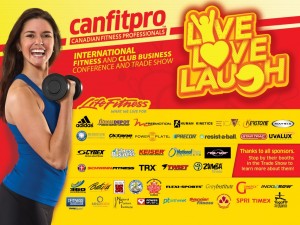

 Entries (RSS)
Entries (RSS)



